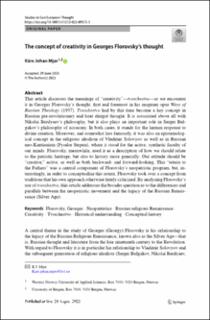| dc.description.abstract | This article discusses the meanings of “creativity”—tvorchestvo—as we encounter it in Georges Florovsky’s thought, first and foremost in his magnum opus Ways of Russian Theology (1937). Tvorchestvo had by this time become a key concept in Russian pre-revolutionary and later émigré thought. It is associated above all with Nikolai Berdyaev’s philosophy, but it also plays an important role in Sergei Bulgakov’s philosophy of economy. In both cases, it stands for the human response to divine creation. Moreover, and somewhat less famously, it was also an epistemological concept in the religious idealism of Vladimir Solovyov as well as in Russian neo-Kantianism (Fyodor Stepun), where it stood for the active, synthetic faculty of our minds. Florovsky, meanwhile, used it as a description of how we should relate to the patristic heritage, but also to history more generally: Our attitude should be “creative,” active, as well as both backward- and forward-looking. This “return to the Fathers” was a central component of Florovsky’s neopatristic program, but, interestingly, in order to conceptualize this return, Florovsky took over a concept from traditions that his own approach otherwise firmly criticized. By analyzing Florovsky’s use of tvorchestvo, this article addresses the broader question as to the differences and parallels between the neopatristic movement and the legacy of the Russian Renaissance (Silver Age). | en_US |

